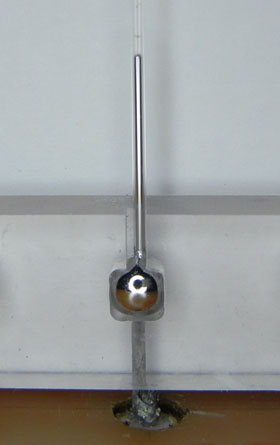
Controlling the shape of liquid metal with electricity could be beneficial in a number of electrical applications
Image credit: Michael Ciranni / Shutterstock.com
Researchers from North Carolina State University (NCSU) have created a reconfigurable liquid metal antenna that can be controlled by voltage using electrochemistry. This tunable liquid metal antenna could play a major role in the development of future mobile devices and the Internet of Things.
Liquid metal electronics has held great interest amongst the scientific community for a number of years; however, they traditionally require external pumps, and these pumps cannot be incorporated into electronic systems very easily.
 This image shows the antenna, feed, and reservoir. Image credit: Jacob Adams
This image shows the antenna, feed, and reservoir. Image credit: Jacob Adams
This has long been a drawback in developing liquid metal electronics devices.
Professor Michael Dickey of the NCSU, coauthor of the study, had earlier conducted studies on liquid metal along with his group at the Department of Chemical and Biomolecular Engineering.
They had observed that when they positioned an electrical potential across the liquid metal-electrolyte interface, application of a positive voltage could lead to spread of the liquid metal, and an application of a negative voltage could lead to contraction of the liquid metal.
The current study is based on these observations made by Dickey’s group.
The radiation pattern, operating frequency and other such important properties of an antenna are determined by the length and shape of the conducting paths that lead to its formation.
The research team employed electrochemical reactions for elongating and shortening a liquid metal filament, and this varied the operating frequency of the antenna.
When a small positive voltage was applied, the metal flowed into the capillary, and when a small negative voltage was applied the metal flowed out of, or withdrew from the capillary.
Using a liquid metal—such as eutectic gallium and indium—that can change its shape allows us to modify antenna properties more dramatically than is possible with a fixed conductor.
Jacob Adams - Coauthor and Assistant Professor in the
Department of Electrical and Computer Engineering at NCSU
The positive voltage "electrochemically deposits an oxide on the surface of the metal that lowers the surface tension, while a negative potential removes the oxide to increase the surface tension," Adams said. The direction of the metal flow is determined by the differences in surface tension.
This advance makes it possible to "remove or regenerate enough of the 'oxide skin' with an applied voltage to make the liquid metal flow into or out of the capillary. We call this 'electrochemically controlled capillarity,' which is much like an electrochemical pump for the liquid metal," Adams noted.
When solid conductors having electronic switches are used, the properties of the antenna can be rearranged to a specific extent. However, when liquid metal is used, the tunable range of the operating frequency increases to a great extent. "Our antenna prototype using liquid metal can tune over a range of at least two times greater than systems using electronic switches," he pointed out.
Mobile device sizes are continuing to shrink and the burgeoning Internet of Things will likely create an enormous demand for small wireless systems and as the number of services that a device must be capable of supporting grows, so too will the number of frequency bands over which the antenna and RF front-end must operate.
This combination will create a real antenna design challenge for mobile systems because antenna size and operating bandwidth tend to be conflicting tradeoffs.
Jacob Adams - Coauthor and Assistant Professor in the
Department of Electrical and Computer Engineering at NCSU
The liquid antenna could be used for a number of different applications in mobile devices.
Tunable antennas can be made very small in size, and can be designed to rectify themselves for near-field loading problems such as the popular "death grip" issue with the iPhone 4 by which calls get dropped when the phone is held by the bottom. Liquid metal systems "yield a larger range of tuning than conventional reconfigurable antennas, and the same approach can be applied to other components such as tunable filters," Adams said.
The research team is now conducting studies on tunable liquid metals, and is analyzing its fundamental and applied elements. "There's still much to learn about the behavior of the surface oxides and their effect on the surface tension of the metal," Adams said. "And we're studying ways to further improve the efficiency and speed of reconfiguration."
The team believes that they would be able to acquire better control of the liquid metal’s shape in its one-dimensional capillaries and possibly in its two-dimensional surfaces, which would allow it to get the required antenna shape. "This would enable enormous flexibility in the electromagnetic properties of the antenna and allow a single adaptive antenna to perform many functions," he added.
This study has been published in the Journal of Applied Physics, from AIP Publishing.
I'm imagine many of you reading this will be thinking about this video:
T2: Liquid Metal
I'm sure that this potentially amazing technology will be used for good though!
For more from Alessandro, follow him on Twitter - @APirolini